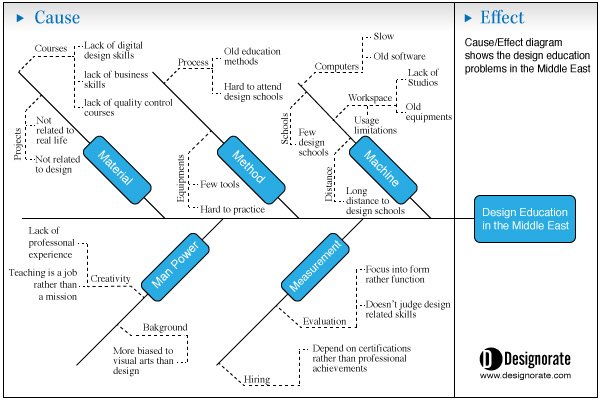Why Design Education in the Middle East Doesn’t Meet the Market Needs
One of the questions commonly asked by young, talented designers and students who dream of design as their future career is, “How do I learn design?” The questions are also commonly phrased, “How do I improve my design skills?”
While the answer to this question is literally straightforward in many countries outside the Middle East, especially in Europe and United States, it isn’t the same in Middle East countries due to various challenges that face design education in the region. On the other hand, companies working in the design field in the Middle East frequency complain about the lack of design skills needed for the marketplace. Most of the designers are not actually prepared to take the responsibility of the design industry in the area and subsequently achieve a leading position in this domain.
While design education plays a key role in the design industry to efficiently prepare early talent to meet the needs of the professional market, little research has been done to address the design education problem in Middle East countries, investigate the different causes, and suggest solutions for these problems. One of these studies is Design Education in the Middle East, a master’s thesis introduced by Doreen Toutikian, founder of MENA Design Research Center. While the research tended to explore design schools in Egypt, Lebanon, and Qatar, Middle East countries still face a very slow development curve in design education, and are inefficient at meeting market needs. The following examples highlight different problems faced by design schools and universities. Feel free to share with us your own impressions about the design education i the Middle East through the comments below.
Limited Number of Design Schools
Along with the large number of companies working in the design field—or that have design departments, such as design studios, adverting agencies, IT companies, and architecture companies—few schools are providing design degrees that aims to fulfill the market demands. Although the last decade saw an increasing number of design degrees provided in mostly private universities, these schools have low capacities in terms of the number of students and budget, which subsequently lowers the impact they have on the market. Most of these schools are established in the big cities, such as capital cities where there is the funding, expertise, and high demand, which makes it difficult for students in other cities and rural areas to find a proper education opportunity.

The travel and living costs make it harder for talents living outside the capital cities to achieve their dreams. In Egypt, for example, students need to travel many hours to reach Cairo, which is the only place where they can find an academic design education. Another example is Lebanon, which is a smaller country, but the high living cost is a challenge for students who would like to learn design in Beirut universities.
Expensive Education Tuition
While the Egyptian education system is one of the oldest in the area, the Applied Arts Faculty and Fine Arts Faculty provide related design education, but the curricula taught in these schools are very old and don’t meet the standards of modern design development, especially in the last 50 years. Additionally, students are faced with an education system that requires them to get a very high grade in high school (Thanaweya El Am’ma) in order to enter these schools, which is considered a barrier for talented students who are simply not quite good enough in non-related subjects such as Chemistry, Biology, History, etc.
On the other hand, most of the newly established design majors are provided by private schools which are very expensive for normal families to afford. The same problem applies in countries like Lebanon which hosts one of the oldest graphic design majors in the Middle Eats at the American University of Beirut (AUB). In Egypt, modern design majors are also provided by two of the most expensive private universities in the country: The German University in Cairo and the American University in Cairo. Many talented Egyptian students are unable to complete their dream of finding an academic design degree due to high tuition costs.

Obsolete Design Curricula
The courses taught in the old design schools share similar problems related to how the courses meet with the market needs. Many courses are using obsolete techniques and methods that aren’t used in the market anymore. These courses should be updated to meet with the modern development in the design industry in order to meet with the market needs. Many students who are graduating from old design school lack the experience that allows them to take on the role of junior designers.
This problem is closely related to the lack of funding and resources required to update the course and equip schools with state-of-art technologies. Additionally, the bureaucratic education system prevents professors and students from using any purchased technologies, as any failure or damages can lead to serious penalties that can result in firing the professor from their position or taking legal action against the guilty student, which limits the trial and error process essential to the education pedagogy.
The Conflict Between Design and Art Education
Even in newly established design degrees, there is still a conflict between design and art. Many of the educators who teach design come from a visual art experience, which reflects in their courses, syllabi, and teaching methodologies applied in class. Although design shares the basic principles with art, its approach is to solve problems and turn creative ideas into innovative products and service. In the modern market, designers are required not only to provide their experience in the form of a service, but also contribute to the holistic strategy of companies through building innovative design processes and using design thinking methods such as mind maps and brainstorming to solve development problems.
Lack of Focus on the Market Needs
A clear understanding to the role of design in companies should be highlighted within the design courses taught in schools. Otherwise, students will find they are wasting their time, effort, and money in courses that aren’t applicable in real life. Design schools should understand their role to fulfill the market needs. Most of the design degrees provided in the Middle East don’t fulfill the entrepreneurship skills that designers require to be able to understand the business system they are working inside, or to be able to establish their own business.
Teaching digital design tools and technologies is also underestimated by most of the design degrees provided in different countries. Students are required to teach themselves the digital design tools that allow them to accomplish projects, which teaches them to depend on online resources and courses that are developed for professional development rather than academic methodologies. The weakness of the digital design courses can be observed in the professional career, as students who didn’t receive quality digital design courses are always in need of support for their digital design projects. They often need help solving application problems such as color management, devices calibrations, and software/hardware problems.

Teaching a quality control and testing process has almost vanished in most of the design degrees, which leads to designers who can’t manage their work properly or ensure the final product is exactly as they proposed in the prototyping phase of product development. As a result of the lack of quality control education, designers aren’t able to control process such as the printing process and digital publishing.
The below Cause Effect diagram visually explores the different problems that face design education in the Middle East and how these problems are linked to each other in order to build a better understanding of how to solve these problems. The diagram is divided into two section. The right one includes the problem (Effect) and the left part includes the possible causes of the problem based on how these problems are linked to each other.

Working Around the Problem
The design education problem in the Middle East has existed for decades, and designers are working around this problem by using the Internet to teach themselves design tools such as commercial softwares, or they go to technical training centers. Then, they start to observe and build their own portfolios, which they hope will lead them to a design position. However, although this type of education is widely known, and the majority of designers working in industries such as the IT and software houses have not graduated from design schools. Building a coherent design industry requires an academic focus and support in order to provide the proper mentorship and complete education experience to students to fulfill the design business needs. The work-around model has been adopted by many designers for years, and while it can help fulfill the market’s basic needs, it can’t drive the design industry to innovate and contribute in the Middle East economy.
Conclusion
Design education is one of the primary factors contributing to the success of the design business in the Middle East. While design companies suffer from lack of design experience that affects the overall innovation profile for these companies, the main reason for the defect is the design education system. Many problems and challenges can be highlighted on his domain that results in designers who lack the basic business needs. These problem vary from financial problems, geographical problems, and educational problems. Highlighting the problems and finding the method to solve it can not only solve companies’ problems, but also have a positive impact on the design industry in the Middle East by increasing its competitive position compared to other regions. Do you see other problems in the design education in the Middle East, share it with us through the comments below.







If this was really considered important enough, the governments of each country involved should put together a task force that recognizes the best design schools elsewhere and select talented and interested students to send to these schools all expenses paid. And at the same time, the government needs to hire great faculty from around the world, but provide resources for them to develop a curriculum that works for all the middle eastern countries. This requires money, research, and planning, and frankly, I don’t see this happening. The Indian government had hired Charles and Ray Eames to revamp the curriculum at the National Institute for Design, but when the faculty they taught retired, they were not replaced by people with vision who were as well educated in design as the initial group and slowly the school deteriorated, in my opinion.
Hi,
I am sorry for the late reply. You are talking about a national design policy–like the one done in India. However, the design education in the Middle East id driven by the market needs. There are some old schools with obsolete curricula and others who got other problems. But the common issue is that there is a lack of good design schools and professors with design background. Thanks! Rafiq